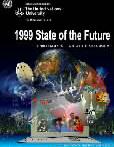The next frontier - How big is big? Douglas C. Engelbart. 1.* - unverified transcript - Andy DiPaolo introduced the Stanford Center for Professional Development and the Engelbart Colloquium. Terry Winograd introduced the Colloquium and Doug Engelbart. 2 A call to arms.3 I was sitting and thinking, I almost would rather listen to him. I wanted to make clear too, that the Unfinished Revolution isn't my personal revolution, it's just what I think could happen, and I hope happens, and it won't happen unless the world gets more conscious or explicitly interested in making it happen. 3A The evolution that's going on now is plopping around
so today. I hope to give you enough perception about why I think that,
unless there is some explicit action taken, it's not going to go very fast
and there is some strategically orientated thing to do. It involves a world-wide
activity. This is one of the pleasures then for getting this webcast and
then later being installed so it can be referred to and then building up
a repository around it and just inviting people all over the world actually
and to start participating, and I can just back up, well, all the people
who know how to do things can start making the community work and get something
done. With that I'll proceed. 3B
Credits.4 All the demonstrations I've given through all the years, I just think that I'm unflappable, so if anything falls apart today, it won't be me. I just wanted briefly acknowledge a number of people that have made a difference. My daughter Christina, sitting over there, she has been involved working professional with this material since 1968, 1978 actually, and then a period where she and her husband did a start-up and all. Then she came and helped me set up the Bootstrap Institute in 1989 and has been working very heavily ever since for it, and a little bit of emergency retreat in the last few months, she I have to acknowledge all a lot. 4A
Jeff Rulifson, he's the one over there, who once came
to work in my laboratory in the late sixties and made a very definite technical
contribution, and then, in the last three years has been making a big difference
in helping us get this bootstrapping going. And, Marcelo Hoffmann, he,
working at SRI, came to one of our seminars about eight years ago. And
then since then, has really been contributing a lot--sometimes taking vacation
time to help us write our proposals, etc. Then Pat Rush and Mary
Dye, who aren't here, came up a year ago to start helping--and are helping
from Chicago. So, we'll hear from Pat Rush a little later today. And, Peter
Yim, sitting over there in the corner--put your hand way up, Peter--he
showed up last spring and was volunteering. And slowly I began to realize
he really meant he wants to volunteer and work. And, pretty soon he quit
his other activities working full-time. So, without him, this whole thing
wouldn't have been able to come off. He's had to stress and do things.
For instance, I'm unflappable up here like this, but I'm also not a very
good manager at all. It takes somebody like Peter; it's always taken somebody--Christina
or Peter or Bill English--to make things work. And then, the next two people,
Pierluigi Zappacosta and Dan Lynch, both contributed significant pieces
of money to help make this particular thing come off. And then, Andy DiPaolo,
and Terry Winograd, and Jean-Claude, you've already been announced by--
I do appreciate very much getting together and letting us use this, as
outsiders, being able to use this Sanford thing. And then, the companies
that have contributed are Sun Microsystems, Logitech, SRI, and I think
the whole staff at the Stanford Center for Professional Development that
Andy DiPaolo heads. I was very impressed with all of that. So thank you.
4C
Stultifying paradigms.5
Okay, as Terry pointed out, there's been a goal I've been following for a long time. It's forty-nine year ago that I, in some wild moment, committed my professional career to seeing how much I could maximize my career's contribution toward this thing of helping mankind's collective ability for coping with complex, urgent problems--getting the picture, even in 1951, of interactively using a computer. That shows you how impractical I am because the nearest working computer was probably at MIT at that time. But anyway, that's been the goal pushing me ever since. 5B
So, like anybody does who doesn't know that much about what's going to happen, you all go to graduate school, so I went to Berkeley. Excuse me. They were building a computer. So, then I got a Ph.D. in '56 and came down to work at SRI in '57, and then was there until '77-'78. We did a lot of things. There were many things that happened in those days that were valuable lessons to me; and, I'll just mention a few of them. One of them was that in the late '50's I began trying to--I didn't have any resource money to do this kind of pursuit--but I kept trying to describe it to people. And I'd give talks, et cetera. I just had exactly these particular three things that are under there [ref. Table 3]. 5D I gave a talk. The first one was: all I need is a twenty-minute turn-around time for punching in my punchcards. And, if it turns around in twenty minutes, what value would I get by interacting with a computer? Well, that was a friend of mine who started the computer science here at Stanford, George Forsythe. So, I talked to that group and it very honestly wondered how you get more value than a twenty-minute turn-around. So, paradigms. It's very hard to explain all the interactions what you would do. 5E And, another group I gave a talk to about this thing--they were totally convinced that all I was talking about was information retrieval, and that was their specialty. I thought they were going to attack me. I'm unflappable, of course. But, they really felt angry. Here I was, an engineer trying to talk about all this stuff, and all you're talking about is a computer doing information retrieval for you, and that's our business. I had ten or fifteen minutes trying to describe to them what I meant. And, it didn't work. But, paradigms see? 5F And then another one was cognitive psychologist, and
his picture was--all you're talking about in this augmenting thing is cognitive
psychology. So, I really learned things from that and a few others that
led me to realize that you have to set up a paradigm, conceptual framework
as the term was in those days. So, that's what I began to do. One of the
valuable things, I got a chance in the late eighties to do a research study
about dimensional scaling of electronic components. I was just sure if
you're going to do computer interacting and all that, to any great extent,
that components were going to have to get a lot cheaper, and faster, and
smaller. And so, what happens when you make things small? So, I got a research
contract and I started looking into that. 5G
Radical change of scale.6 It turns out that physicists have done a lot of work upon dimensional scaling and have some nice abstract concepts. You plug them in here and you get to realizing that. The more I studied, the more it became clear that you make a small change in the size and it just often times makes a noticeable quantitative change. But, pretty soon the change gets large enough that you're going to get qualitative changes. And then, if you get even larger ones, you get really surprising qualitative changes. And it was that thing about really surprising ones that just was an extremely valuable lesson for me--that I'll point to a little later, when we're getting to. But, anyway these are some things that most people wouldn't know how to answer. Like, if you were as small as a mosquito, what would it be like for you? 6A
Well, in the first place, you'd be extremely over-muscled, et cetera. And, if you flapped your hands fast enough you might even be able to fly. And, gravity would have almost zero meaning to you. You'd have a small problem, though: you'd have a blunt face, et cetera. And you'd get thirsty, and so you'd find a place of water, and you'd go up to take a drink, and the surface tension of the water would not let you get in unless you bonked. And then what would happen is, your face would get wet and the surface tension would suck you right in. See? So, that's why mosquitoes do well with these big, long skinny noses and stuff like that. So, these things are surprises, right? 6C So, if you were ten times larger, it would turn that you couldn't move. You'd weigh a thousand times as much, but you would only be a hundred times as strong. So, it'd be like, if right now you weighed fifteen hundred pounds, or a thousand, or twelve hundred, or something like that with your current muscles, et cetera. You just couldn't move. And, if you stumbled, you'd break bones. And, you'd have trouble breathing because you only have--the ratio of lung surface to body metabolism is ten-to-one at that point. These are just things that you don't think about, surprises. So, I'll say if digital technology was smaller, or faster, or cheaper by a factor of a hundred, or a thousand, or a million, or ten million--what would that do? 6D
These are things, as we talk on, just keep that in
mind: this relative scale business is very, very critical. And, it's part
of that paradigm bottleneck that we're having, that I feel that we're having.
If we're going to, after this revolution ... People say, "What revolution?
What, we're already doing e-commerce. And, I'm on the web." Okay. So, anyway
this is a very telling thing--the face of the greatest avalanche of pervasive
global change ever, ever, ever faced by human society. That's a scaling
thing: the amount of change being introduced and, principally, you can
only just credit it all, if you wanted to, to digital technology getting
so pervasive, and cheap, et cetera. Going to hit every place in the world.
It's going to start changing a lot of things. It just makes more change
than we ever, than any society, ever had to accommodate in that time. So
if our paradigms don't get unlimited, don't get unchecked like that, we're
going to have a dangerous time about. A big part of today is trying to
open some of the paradigms about scale, and then you realize that scales
of things get large enough, you have to think in a different way about
what you're going to do about it. And a different way comes about in a
sense, a sort of a really strategic way, instead of a frontal attack. 6F
Evolving social organisms.7
So, this key thing here then is, is look at the human organization, talk about collective action. So, I found it very meaningful to consider any human organization as a social organism. There are some very real connotations associated with that. And, one of the things you look at, if you put an envelope around any organization you know, and you say, "I'm just observing from the outside world how that behaves." So, how will I judge how smart that is? By how quickly it sort of senses what's going on in the world that's important to it, and takes some action? And, how well it co-ordinates its resources? This arm would be reaching for something and this is trying to slap it away? Human organization is very strange. But also, the issue then of collective IQ.--it's not just a buzzword. 7B It's something very meaningful to me. And I think it's meaningful. These are the kind of things about which subsequent dialogue would be very valuable; to get more people in the world trying to look at this seriously. And after then banging around a little bit, and find that I'm unflappable--I probably go home and cry maybe, but .... So anyway, evolution has been happening to human organizations all the time. So, in this case, this radically improved nervous system. Bingo! 7C
Just within a few decades potential technology acted as the potential nervous system. And, so these are the things I was writing about in 1960. You know, saying, "Hey, that's what it is, essentially." You take any given organism, a biological one, and if you suddenly make its nervous system immensely more effective--its sensory, and its perceptual, and its motor control, et cetera, things like that, and it's cognitive. And it says, "Wow!" What's going to happen? Is it just going to do that for say a lizard. And it says, "Oh boy! It'll be a lot smarter lizard!" And, you begin to think about it more, and you realize that the evolution from there on, learning how to co-evolve the rest of it, to harness that kind of nervous system, would begin evolving into a very, very different creature than just be a smart lizard. So, this is the kind of thing we got. 7E So, anyway there are various ecological niches in which evolution takes place. So, organisms that find themselves in one evolution niche will grow in one way, and those in another will evolve. So, this is already happening out in our world. Like, the ones that are doing e-business/e-commerce, if that's the world they're in, boy, they have to get going; and those that are not affected by it, don't. But there are some aspects of that, in which, it's extremely important that the niches don't get, sort of, too far away from each other. And one of the things then to do would be: how do you, sort of, in your niche, or organizations in your niche, sort of, keep track of the others? Because there are a lot of things happening that could either be hazards or really things to benefit from or copy. And so, another aspect of it is, of any organization that you're particularly concerned with, is evolving to learn how to harness all this better. Oops! You have to realize that you have to watch the environment you're working in. the other organizations. Because if they're evolving, if you're not paying attention to how they evolve, they evolve one way and pretty soon you're out of touch, you're out of sync, or something, with them. 7F So there's that double pressure on the evolution of
every organization: how you evolve to be more capable and effective, and
efficient, and all those different terms, but also how you stay in synchronization
with the rest of the environment. Which is, I don't think that's being
cared for very much. 7G
Terminology.8 So anyway, in the whole time of this colloquium there may be fifteen or so special terms and concepts that all end up being interconnected in this framework. And so, one of them capability infrastructure, another is collective IQ. And so, we say yes, this turns out to be something that I focused on almost forty years ago, as saying, that seems to be the term, if you're trying to learn how to harness this technology the best. This considers the sort of capability that it's going to produce in people and organizations.So anyway, the paradigms that have been guiding and applying the evolution in the past, or in the current lifetime, to me, they're too limited. So, part of what I hope to do out of getting people interacting and evolving in this kind of framework is to help extend and get paradigms that are more appropriate. 8A
How about this capability infrastructure thing. Well, I used to call it a hierarchy, and somebody, after a couple of years of that pointed out, "It isn't hierarchy." 8C And, I said, "Oh, absolutely not." 8D "Oh, well don't call it that then." 8E So, infrastructure is the term. See, I'm unflappable.
That was quite a few years afterwards, but I smile and think, "Okay, people
are always teaching me better." 8F
Collective capability.9 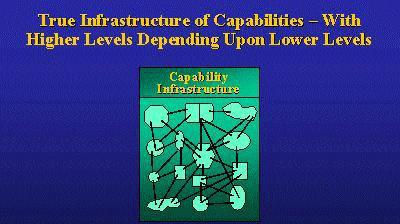 Fig.
1. 9A Fig.
1. 9ASo anyway, the infrastructure, in this sense, means that any of those capability blobs in an organization is usually dependent on other subordinate capabilities [ref..Fig. 1]. You know, if you say, well, we want to have the capability for having a team meeting and get together. Well, they have to have a capability for alerting everyone communicating with them. They have to have the capability for organizing a meeting, or the terminology for what you call a committee meeting. If somebody's going to take minutes or something, there's convention at that, or something. But anyway, all point up and down the line there, it's really an infrastructure of capabilities. And, you can't suddenly just say, "Oh, the company's core competencies, that would be the top level capabilities, we've really got to focus on them. Sure you do. But, you can't really make significant changes in them without looking down into the hierarchy to see what other candidates to change. So let's just go another step. So people, this is where I ran into a real .... I guess I was flapped in the seventies. We were doing this augmenting and we had a system, that later on in the Colloquium that we'll start describing a lot of the things it had which were truly unique. 9B We were really out for augmenting. Assuming, that every knowledge worker is going to be equipped with a personal computer and what they want to do with it--decide well, collaborate and all that stuff. So, then what happens if the popular term became office automation? So, the picture was that this technology was there to automate your office work, and principally the secretary; so the principal unit to be concerned with was the secretary unit and their terms. And, this is the thing that just taught me one of the real, real lessons about paradigms because what it would do is just put me out of business. My research money dropped to zero because you're going in the wrong direction. And, you're way too complicated because, compared to today's array of tools and things like that, it wasn't that at all. 9C There are many things then that got installed into the computer world that I still think show paradigm imbalance. And, one of them is WYSIWYG, what you see is what you get. They're very, very proud of themselves for being able to have the screen resolution, et cetera, and the software, et cetera, that you could make that look like a real page with font on it. And so, this oriented that the whole point of what you're going to do in the end was to print it out. And so, you'll see what you're going to get there. And, that was the thing. 9D  Fig.
2. 9E Fig.
2. 9EAnd we started out in the sixties by saying, "Hey, being on the computer has lots of advantages." That's where that scaling thing--there's some surprising sort of changes that you can offer. Scaling brings you this much capability and horsepower. Hey, let's just see. I can do things different from what the old book technology did. One of them, right away, was I have quick options of how the view is--well, just show me the first line of every paragraph. This just helped a great deal in finding my way around. And many other things that we ended up with--view specifications that had maybe thirty to forty different kinds of viewing configurations that you had. Then you get to learn to use them. And you just miss them a lot if all you can do is scroll. So, the paradigm is still hooked on that. That's the way that almost every system I see is still built like that. So anyway, there are many things about the interface, too, I'll talk about later. Here's the big thing, that you say, "Oh, yes. We're putting this together. And, all these tools are great.". 9F 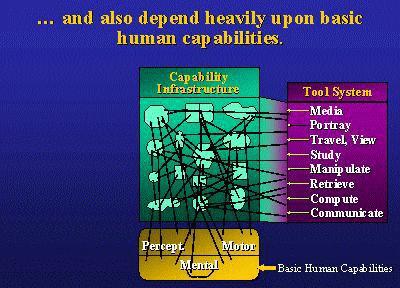 Fig.
3. 9G Fig.
3. 9G... and, we have to realize that basic human capabilities lie at the bottom of this infrastructure. In the end, almost all the capability you do have up there depends on it and some aspects of it, as well as on the tool systems, as well as--oh, look!--on skills, and knowledge, and training that, that basic human creature has so that you know how to use all this stuff. 9H 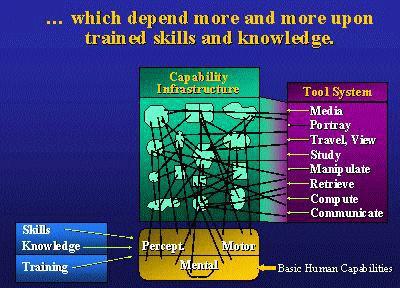 Fig.
4. 9I Fig.
4. 9IOh, it's not just that stuff is it? No. There's a bunch of other stuff that you just grow up learning about. And, this whole set, then, is what we call the augmentation system: that people that are born with a very basic set of elemental capabilities have to learn about all the rest of this before they can be effective in society. And it becomes then if you're operating in a given capability domain out here--oops, sorry, wasn't ready--in a given capability domain in here like that you have to go to school to become a very, to become a professional this or that, and have a lot of training. 9J 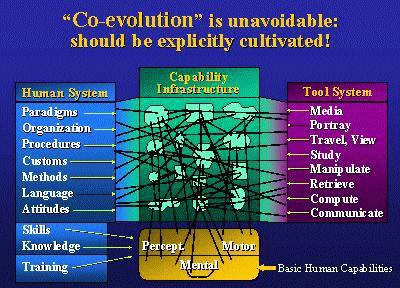 Fig.
5. 9K Fig.
5. 9KWell, the very way in which those roles are integrated into a team that you call a company, or an agency, or something of that sort, is also a human the system. And, you say, "Wow! Look, this technology, explosive. It's going to change a lot more than just the way you look at, so you don't have to look at page things and scroll anymore. You can, oh wow." Pretty soon you find that all throughout this infrastructure here there are real candidates for harnessing the technology and harnessing lower-level capabilities that got modified. And that whole infrastructure is due, is bound to make a lot of change in it as the organizations evolve to learn how to harness this whole thing. To me, that's the unfinished revolution. 9L And, I was kind of uneasy last year when it was Engelbart's unfinished revolution. I kept saying, "Well, no. It's humankind's revolution that's going to come about. And, I just want to get it pointed out enough, to get enough people moving on it, so I can sit down. So, this is the big part. 9M 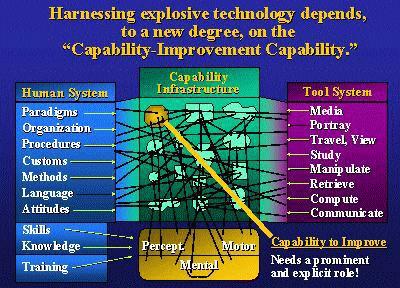 Fig. 6. 9N
Fig. 6. 9NSo, this is another way of looking at: organizations
take a long time to do the stepwise changes. And their time constants for
change are very much slower than the environment's changing now. So, this
is going to lead to some real problems. 9O
World's urgent problems - 1. 10 We have some very interesting potentials. One of them
is--I'm unflappable; I had the wrong one out there. Peter Yim, could we
get the camera on that boo. 10A
So Peter Yim, last spring, point out to me that there was this group of people working on the scenarios for the future on a really global scale. On a really global scale. And, he had been serving as part of one of the committees on a committee structure that had been evolving this kind of state-of-the-future picture on a global basis for the last three or four years. So, we're lucky enough to have unveiled a video clip voluntarily made by Jerry Glenn. So, we switch back to the slide please? One of the principal instigators and coordinators of this effort of producing this state-of-the-future books, which are just very, very interesting. They've isolated fifteen major global sorts of vectors that need watching. Jerry Glenn is now the Executive Director for the American Council for the UN University, and the Co-director of the Millenium Project. So, we're going to start a clip now of a few minutes. He'll just give you a picture. 10C But, the big thing is there's ... GLICH IN TAPE (5 SECONDS) ... looking at this big picture. And, the scale of the problems he's going to point out is just very.... 10D State of the future by Jerome Glenn, Executive Director, American Council for UN University Co-director, Milennium Project.10E GLICH IN TAPE (1 SECOND) ... I almost feel like saying, "Thank you, Jerry." We're going to see another clip or so he's made. And, also he's scheduled to come by and visit us later in this Colloquium. 10F Another big problem is world energy supply. A good friend of mine, Hugh Crane, has been telling me about this for years. And, he's been telling me about the great knowledgeable guy he's teamed up with, Ed Kinderman. 10G Hugh is going to come by later with his kind of picture of it--not today. And, Ed Kinderman is going to ... he's putting on a clip. So, Ed's here today. Where do you sit? Oh, there he is. He gets to watch himself. Are you flappable? Okay. So, let's have Ed about energy. 10H State of the world's energy supply by Ed Kinderman, PhD Chemistry, Senior Energy Researcher ("Emeritus").10I Bootstrapping.11 Okay, very good. So, thank you. So, we sort of look, for me then, the many years ago because I was looking, I said this would be a very good goal, to try to see how much one could improve mankind's collective ability to deal with complex, urgent problems. 11A
So, as one gets to look at it in the kind of scale in which it exists, you begin this subtle thing of, "Why didn't I realize that at the outset?" That purposely pursuing that goal itself is a very complex and ever increasingly urgent challenge. So I said, "Oh, that's interesting." So, these are things that I brought up in this framework book that was published in 1962 as a technical report--a sort of pared-down thing that somebody else abstracted and was later put into a chapter of a book. That was the sort of genesis for pulling these things together, et cetera. There were some things in there, the diagrams, that you can look at and say, "Oh, look!" That come through at all? 11C 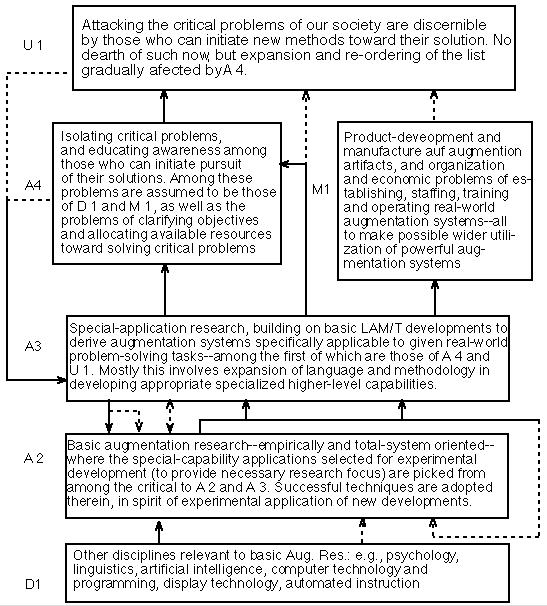 That was the sort of genesis for pulling these things together, et cetera. There were some things in there, the diagrams, that you can look at and say, "Oh, look!" That come through at all? 11E Voice: Yes. 11F Oh, great. Better than I thought. 11G Here's the world's plying information center, and here's the program that's going to try to improve capability to do complex things. Oh boy! The faster that gets going, let's feed it right back in so it's employing these new capabilities to do its work about how you develop new capabilities. I used an engineering term, bootstrapping, to talk about it back then. And just say, well the world's certainly going to get turned on to that pretty soon and get going on that, and when they do. Oh, there's quite a bit more to it than shows up there, but I guess you can zoom it. 11H There began to be a sort of network of kinds of activities, some of them feeding back, and others, et cetera. And, the very top one ["Attacking the critical problems of our society are discernible by those who can initiate new methods toward their solution," Ed.] is really saying that which is attacking the rules, or the goals. 11I This set me out on this bootstrapping sense, and it steered very much the kind of research pursuits that we did in the sixties and seventies. Saying, okay, if we're going to learn to do collective work better, let's really do it. But if, we're not going to sit there and write reports to tell the world about it, we're going to show them. We're going to have to do it ourselves. So, everything we built, et cetera, was to improve the capability of the environment we lived in, and we all lived in it. 11J There wasn't exactly a homogenous perception about what that would be like. I mean, there's a category of workers that's called software people, right? who seem to have some of their own pictures of what ought to be done in the world and all. And, that was a paradigm lesson, too. But, as got that going and we got this other paradigm that the rest of the world just thought we were really, really in the wrong direction. But, this whole pursuit in here is sort of the foundation for the kind of things I'm telling you about now. 11K There are a lot of lessons learned. And, a lot of them, you know, instead of getting flapped and getting all morose and grumpy about the world because they shut down my research, it was just saying, "Oh, that's a real sign of paradigm." And, the challenge becomes, not only just thinking of clever things you could do about tools and methods, et cetera, too improve work, but how you get the world moving in that direction. And, in that sense, I've been a very, very poor marketer and salesman about that because, you know, the unfinished thing. I think it's time that the world really says, "this is a very, very important target for us to do, to go after. And, let's go after it." And, that means going after the collective capability. And that takes both academic and then sort of engineering and real-world applications, sort of all interacting and talking with each other about that. 11L So this then leads to the step of looking at this capability infrastructure and saying, "Oh, we have to give new importance to the capability within any organization's infrastructure that serves to improving its own capability infrastructure." So, it does imply there. That was just great. So, that's part of the bootstrapping then--how do you get people's improvement infrastructures to be very active, et cetera. And so, that's another term: improvement infrastructure. And, that's a subset of the capability infrastructure for any organization. 11M 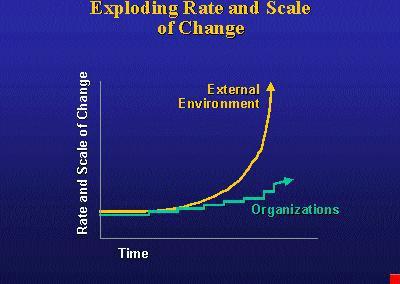 Fig.
7. 11N Fig.
7. 11NOne of the things then, in listening to the global problems, you realize, "Oh. In one way you can just put the whole of mankind into this capability infrastructure box and say, 'Oh, what's the ability of mankind to take care of these global problems that Jerry Glenn was talking about, and Ed was talking about?'". 11O So, that's a very clear capability that has to be
there, and it's not doing very well now. This kind of thing--forty years,
you know, we'd run out ...--well, forty years is pretty short time for
the change time constants of many of our large organizations, and especially
large political groups, and such like that. And, the other things that
we'll be talking about today of that sort, too, so .... One of the things
we're getting out is the scale of the problem if you're going to get large
groups of people to be more capable of doing their collective thing. You're
talking about, well, we'll sort of categorize them a little later. 11P
World's urgent problems - 2. 12 But, let's switch. The next clip we'll have is by Dr. Rush, who came on the scene a little over a year ago. She and her colleague, Mary Dye, were pretty active in helping us push towards doing all of this thing. 12A She's got a MBA, so she's mixed both the management of hospitals and such in with the actual practices. And, she's really become almost totally concerned with how to improve the health service state. So, can we run that clip, please? 12B State of health service by Patricia Rush, MD, MBA, Rush-Presbyterian-St. Luke's Medical Center, Chicago.12C So, the pictures grow till you realize that the kind of distribution of the capabilities to deal with complex knowledge, and arguments, and issues, and policies, et cetera, are widespread. You don't get that by isolated cases where a few different organizations can exercise really neat, special techniques. Well, anyway, we'll get at that more later. So, we have another one right now, too. What I called the state of the biotechnology, which is sort of one aspect. Curt Carlson is the president and CEO of SRI and he's becoming more and more active and interested in what we're doing. 12D He's actually helping make SRI sort of a partner in getting things moving. And, we'll tell more about that today. Unfortunately, to keep SRI moving well, he's had to do some active CEO-ing this afternoon; but he'll be here for the reception. So, watch and listen, and maybe corner him and ask him questions. 12E State of biotechnology: Values and threats by Curt Carlson, Ph.D., Physics, President and CEO, SRI International.12F And, there are more. You know, we could have a long parade of people pointing out really, really serious issues. And some of them, in the sixties with all that nice rebellion going on, I became aware of things in this sort of spiritual domain--and thinking: oh, boy, if you solve that, then you wouldn't need to worry because most of the other problems wouldn't get painful, you know, if people learn how to adapt. Then I realized if you try to get the world really programmed to bring their spirituality up, and everything, you'd have to do a lot of communication, and distribution, and agreement, and develop vocabularies. Oh, you're right back to how valuable it would be if we could augment our capabilities. This is sort of a circuitous thing that I managed to justify my doing this all the years. 12G Anything else important? Well, yeah. We're back to this picture [Fig. 6], enough just to start realizing that the changes that are coming about, in themselves, are going to cause and complicate everything. 12H Let's say, transportation's getting a lot better, well, people are going to be carrying their bacterium and their viruses around with them more, distributing--just a lot of problems. People can say, "Oh, telecommuting can solve it." Sure. And then, pretty soon, I've just been saying for years, "Oh, it's going to be very interesting then all the government forms, of local, and state, and so on, to depend significant revenue upon sales taxes, or something, or business taxes. How are they going to sort of settle that problem when you say, 'No, the company I'm working for is in Singapore, or Hong Kong, or Germany, or something'?" So, I saw on PBS, the other day, a real go-around going about state governors really trying to say, you know, that they're slipping away too much of the revenue that we've been depending upon, and it's unfair. So, big problem. The problems aren't just mechanical, solving complex engineering problems, or something, it's solving political, social problems--and, solving the problem of immovable paradigms, which, sometimes, is sort of important. 12I
I made a mistake here, and I'm not flapping about
it, but this first line under problems should have been down, is duplicated
down below. The problem part of this thing, in Exploding rate and scale
of change, that there really gets to be a vicious cycle of urgency
and complexity in global scale that are going to get wrenching. And, those
are going to get more. And, they're getting more because we're getting
more globally active and globally integrated in all of the kinds of things
that we're doing. A lot of that is due to technology which is going to
cause disparities and all sorts of problems. The opportunities are there.
Well, hey, we can boost our capacity for effective collective interaction.
So, this just comes right back. And, talking about problems that .... There's
a young man sitting right there, in this seat, that's active with the nanotechnology
people in the community. And, we were going to get some films with it,
but we just didn't have the bandwidth to put all this together. But, we're
going to have some more. And, I'm going to tag you for talking about some
of the complexities that are rising out of that as well as the stupendous
possibilities that are there. So, we just take a look at how we're going
to do something about increasing our capability to handle things collectively.
12K
Dynamic knowledge repository.13 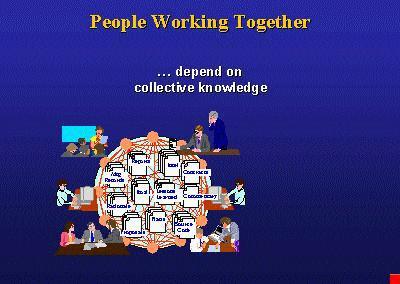 Fig.
8. 13A Fig.
8. 13AWell, it's just basically unavoidable that you have to have collective knowledge in order to do that. And, in the past that's all been hard copy. In the pace that's going now you just realize that there's just not time for the hard copy to change. It's not dynamic enough. It's not transportable enough, et cetera. It's just inevitable that the future's going to be all hyper-media--multimedia and hyper-media. And, the "hyper" comes out just because the inter-linkage is just a critical innovation. That's one of the things coming out of that book. It's just inevitable. So, we say, my lifetime goal, then, got a little bit of additions. 13B
So, not only the goal to make, as possible, to boost mankind's capacity for coping with complex, urgent problems, ut this observation that this pursuit is itself a complex, urgent problem. So, strategy: as make headway in goal A, then apply its new capability gains to the pursuit of A. So, call it the bootstrap strategy. So, that's according to the diagrams I was showing you there. So that strategy begins to evolve into bigger and bigger scale strategic concerns when it's doing that-- to try to do something significant. So, during the course of the Colloquium we're going to be trying to get the picture. If I just give you the one short picture--the kind of strategic issues, and concepts, and guidelines that I think are going to be necessary--they're just pretty hard to absorb until you sort of get, for yourself, this backdrop of the complexity that's there and the kind of integration throughout most of the population of the world of the a lot of the new things that are going to happen, including new vocabularies, et cetera. Excuse me. In making the picture, long ago, about how does a group of people, interacting, start doing that, there are these three categories of knowledge packages that grew out, pretty much [see Fig. 9]. We like to think about the recorded dialogue, and email's been making a big difference in that. 13D 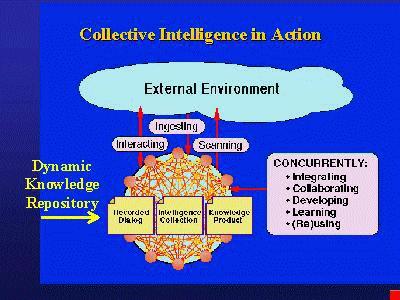 Fig.
9.
13E Fig.
9.
13EBut, that also means every submitted paper in a journal, every news item that's in here like that, every letter-from-the-editor, et cetera, and then, each serious book or review of it, or a commentary. This is going to change from whole books to just getting more and more as the evolution of the core kind of concepts and arguments and discourse going on. Because there won't be time that you'd look at a specialist in a field that's going to put out a textbook that defines that field every, what, two years? 13F Some people have said that in another twenty years the world's knowledge will be doubling, how often? Well, it's been a hundred years lately, it's been five hundred years quite a while ago. Well, in twenty years, they say, it'll probably be doubling every three months. So at that rate--and that rate is just going to be with us, the rate of change--how do you integrate enough so that you can keep track of it to be useful. So, it's not just a problem for any one person, or any one-university crew, or anything like that, it's a problem for every organization. It has to keep track of what's going on in the outside world--and, doing that, the complexity's changing. And so, you need an intelligence collection; and, you need this business of integrating. It's a very critical issue that is not going to be served be having a good search tool, et cetera. 13G That's just, it's everyone that wants to find out what the current status of a big, complex project, or a big issue that's handling a political thing has to go look at all of the dialogue about it. You haven't done something. So, somehow our social organizations, et cetera, have to solve this problem of doing the integrating in shorter and shorter, faster ways, in more and more complex environments. That's a big, big challenge in there like that. We call this dynamic knowledge repository, DKR for short. 13H And, learning how to establish, and maintain, and
keep up to date a DKR that really gives you the picture of what's happening
outside your organization that's effective and what's happening inside,
and being able to control your changes, and your thoughts and your avoidance
of problems, and your taking advantage of new opportunities. So, that's
just very dynamic. So, that's a big thing and we'll be talking about a
lot of the aspects of that over the coming weeks. It takes advantage of
a lot of the research and stuff that's going on in the world. And, Terry
here has just contributed a great deal. And, it's got a much bigger environment
than any one team or academic can handle. No one knows how yet. So, it's
one of the real problems. So, one of the big problems that's there is that,
suppose there's an organization unit down here that's doing a pretty good
job of its dynamic repository but it happens to be part of a much larger
group. So, this might be a design group at Boeing. 13I
CoDIAK.14 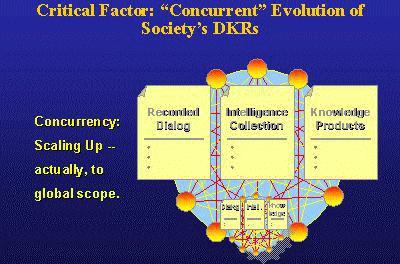 Fig.
10. 14A Fig.
10. 14AAnd, here's the whole airplane. So, each of these groups has to keep its dynamic repository relevant and dynamic to do its job. But, at the same time the overall one has to do that, too, which has to be integrated; they all have to be integrated together. So, this integration goes farther and farther. The whole aerospace industry has to be like this --with all the vendors and parts in it, too. So, this infrastructure of inter-operative organizations, and institutions, and social units throughout the world all has to maintain that. So, for stability, et cetera. For mankind just to know. The fractures that appear cause wars, or other kinds of stuff. So, that concurrency makes a really big problem out of it. 14B So, its just saying that the standards for the way our knowledge packages are made--and the vocabulary by which we talk about the objects in it, and what you can do to those objects to show, and move, to respond to, to backtrack, et cetera--has to be a uniform, wide vocabulary. And, it just simply won't fly in this scale to think of that vocabulary being established by the vendors of the tools systems at all. 14C So, this brings out the absolute necessity of the end-user organizations becoming really proactive about the way the standards in the community, and the functionality that they want, and the co-evolution of their own internal processes, and customs, and practices along with the tools, rather than having the tools be shoved because they're a moneymaking thing right now. Sure, I can't argue with the market for such a tried thing for trying to be able to get cheaper and cheaper, and better and better brooms, and stoves, and things like that. But, when you're into an area in which organization, collective groups of people, is the customer in there. 14D And, they're not able to be good consumers, because they've not got it together yet about what they need and what the future can do. You can't blame the vendors for shoving them around in a way that will be probably kind of laughable. I mean, assuming we do get a lot smarter about getting smarter--that in fifteen, or ten years, or twenty--I think it'd be really interesting for them, you guys, to look back and sort of chuckle about a lot of the world views about the way that this information technology world is going to be moving, or was moving at the time. So, it's our own fault. So, anyway, we adopted this term CoDIAK. 14E 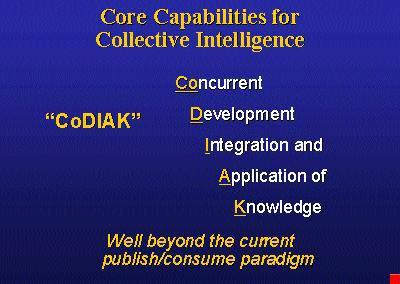 Fig.
11. 14F Fig.
11. 14FIt's an acronym for: Concurrent Development Integration
and Application of Knowledge. Knowledge management's become a term
in the world a lot in the last years. And, later on, Marcelo Hoffmann,
who's been specializing for SRI's Business Intelligence Unit and watching
that, can sort of give us a talk about all that. But, it isn't wide and
deep enough, what has to be done. So, here we begin to talk about the co-evolution
term. 14G
Co-evolution frontiers.15 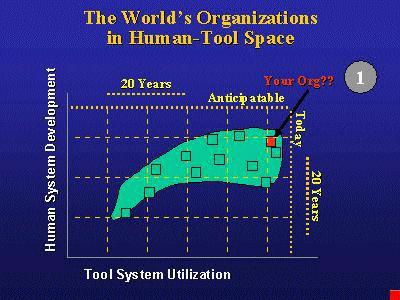 Fig.
12. 15A Fig.
12. 15AAnd so, this [Fig. 12] is a very simplified way of looking, of saying, if there were only one dimension to the technology and tools, and only one dimension to how we adapted to it in the organization, you'd have this two-dimensional frontier. So, what's really interesting --and I just--a lot of need out there for people to help get the dimensionality of these two vectors oriented a lot so we can get a better picture for the evolutionary path out to that space because it won't be just a two-dimensional space. It'll be a many-dimensional space. But, just in two dimensions it's enough to give you a picture about the challenge, see? 15B So, you could just pretend you can go around the world and look at all the different societies and social units and sort of find a way to put them there. How much of the technology that's available today are they using? And, how much have they integrated it, really, into the ways in which they operate and work? And, so you'd get a distribution like this. And, everybody sort of in our modern, up-front world, I guess, would like to say, "Oh, our organization's right up here, huh?" So, then it's pretty clear to say, I mean, pretty important, to say: What can you anticipate today in the way of technology changes beyond what's there now? And, what can you anticipate the way you could, even today, change your .... 15C These lines shouldn't be straight, by the way, but I don't have enough patience where I get unflapped, or something, about trying to make this a better shape. But, it's just there for demonstration, discussion purposes. So, anyway, you look at this and say, "Okay, organizations have been evolving for a long time." And, always they hear about new things and in some order that they'll start integrate new technology in; re-engineering, or some other thing, and change there. So, there's a steady migration in the upward diagonal, like this. Okay, is this the picture of today? 15D Well, today, what you need to do is do a little bit of modification. 15E 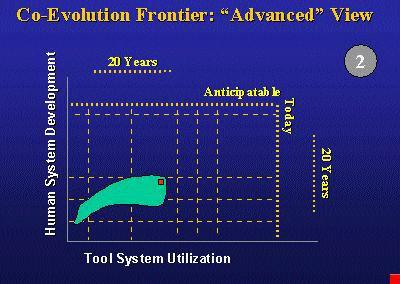 Fig.
13. 15F Fig.
13. 15FAnd, you say, "Oh, it's more like that, right?" Oh, technology's going to come blasting out of that, so it's opening a whole new area. We're moving around from organizations that have been living in this world--...--for a long, long time with all the practices about changing their ways. 15G Suddenly, they're here. The task and the cost of migrating out into this space is co-evolution, driven by the technology that's probably going to be a feeble line moving slightly upward from horizontal, and things like that. But, how do you know it's not want to go this way? So, it's a big question then. 15H
And, you look at the scales of changes that are coming on by the technology, and the nanotechnology that we're going to have some discussions with, and subsequent sessions, too. It's just mind blowing about what that is going to offer. The impact is going to be very large. 15J 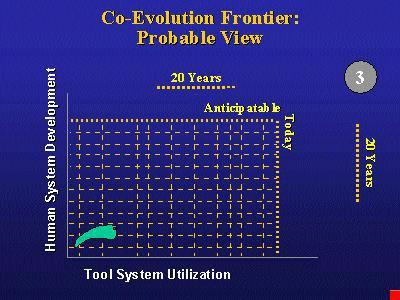 Fig.
14. 15K Fig.
14. 15KSo, okay, maybe this [Fig. 14] is more like what that co-evolutionary frontier is like. So, our practices and concerns, the money we're spending on organizational change--on studying it, and looking at it, like that--are they anything like what's sort of required of the scale for adapting? Not just ...don't just adapt the way everyone else does because they're changing the technology, if you're not going to change to it. It's just going to be a big one. 15L This is time, I think; I can take a reasonable break here. So, let's just see if that five minutes is for true. So, we'll see you back in ten minutes, or whatever, okay? 15M - Break - Urgency.16 So, I know, I could just tell by the quiet way you guys were all murmuring to each other that these are all pent-up things you really wanted to talk about, or maybe you were talking about some of this. The whole purpose of putting on this Colloquium, at least from my point-of-view, is to try to get real dialogue going on in the world. And, it doesn't necessarily have to be dialogue that necessarily agrees with me, but to have dialogue that can be constructive to go along in this direction is what I really wanted to see. 16A I used to keep myself able to keep plugging along with this; waking up at four o' clock in the morning saying, "Geez, I've been fired." I've been all sorts of indignities, et cetera. Why keep this up? And, then I'd go through every year sooner that the world can really purposefully get going, and effectively get going on this, this could mean survival, or avoiding really, really big problems. How would I feel if I quit and sat down? And, took an extra month or an extra year, which might be a dangerous point? You see, I'm really hooked on this kind of thing. I hope it's contagious. That's all I have to say. 16B The plan we have is that we're really getting people out there to be encouraged, which includes you in the audience here, to be encouraged to get involved and start contributing thoughts, and arguments, and examples, et cetera, and links. And, the more that what you contribute is integratable effectively into a dynamic knowledge repository, the better. So, without having the kind of funding that it would really take by any stretch of the imagination, we're using volunteers to just sort of get an initial sort of way in which the dialogue can get going. And, we can build up documents. And, we'll actually learn how to harness the kind of video record that's going on here. 16C This is something that you need to get registered
in there because we want to be able too have the rights that anything people
contribute can be integrated into a open kind of knowledge base that's
growing. So, we don't want to run into entanglements that someone who contributed
something, and if we do make it generally integrated into the public, that
they'll say, "Wait, wait, wait. That was a private, not meant to be that
way." It's causing us to, a little bit regrettably, putting in some of
this red tape. But, we are really trying to encourage this. And, we'll
talk more about that every session, and in between. 16D
Documenting for interoperability.17 So, anyway, in looking at this frontier, in trying to look at it with the scale of the change and say it isn't just your company, or your university, or your political organization, or something that's got to move out of here. The whole environment you're in is going to be moving. So, every one of these little dots [Fig. 12] that's an organization will be moving and trying to find its own way out there. Excuse me. I should use a one-button mouse, I guess. That's been one of my paradigm issues ever since the one button for a mouse is just wasting digits. 17A Voice: What about a five-button mouse? 17B Well, people asked me why our early mouse, mice, only had three buttons. And, I said, "Well, that's all we could put in it." That was the deciding point because of the technology we had then and the funding we had available. So, yes, five. Anyway, now you've distracted me. What was I saying? I must have been heading on some ... 17C Voice: Next topic. 17D Next line, okay. Yeah, how'd I get ...huh, I found a new button. Okay. So, some of the things that I was doing over this last twenty years, after being, sort of, gently nudged out of the research world, was be part of McDonnell Douglas Aerospace. It was very, very useful education, to just see, seriously considering how you could bring this sort of thing into the design world and then realizing that the design and manufacturing need more and more in their planning and setting up to be integrated. And then, they said, "Oh, that isn't all." And, they showed me this picture of the tiers of suppliers that go into. 17E 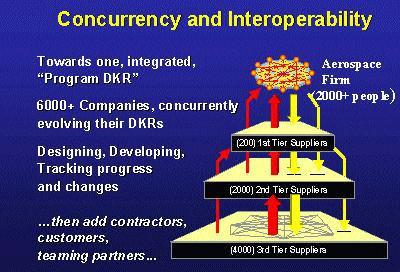 Fig.
15. 17F Fig.
15. 17FSo, this was what they said, typically, for a fighter plane. These guys were in the fighter plane area like that. They said that you might have up to two thousand people in the major contractor work, doing the designing and all of that in the manufacturing control. And you might have a couple hundred first-tier suppliers. These are people that you say, "Oh, we putting up the specs for the rest of it. And, we want you to be doing the landing gear, or the radar, or something of that sort." What they do in the design, these first-tier guys, has to be very closely integrated with the requirements, and planning, and specifications. And, the specifications have to go on down. And than, when any one of these things finally gets a contract, that sort of specifications moving back and forth, and if any them are requirements changed trying to keep that up to date is a real challenge like that. And then, when they do ship a product to get assembled up in here, every one of them has to have been tested. And, the test records of that product have to be connected with it. So, they have to know which airplane, in which shift, under which supervisor of the assembler like that, this went into so later they can go back, when things are out in the field, and really backtrack on problems that occur like that. 17G When they showed me that, and I realized that, oh, the kind of knowledge packages that you're going to be building are going to get more and more sort of sophisticated. And, oh, that saves that vocabulary sense of the way the objects that are describing in there are encoded and described in the language they're in and in the way the functionality and the tools are used. Just at least the verbs and nouns. 17H So you see, it just could not possibly be by separate vendors who each have their own way of doing it, just impossible. It's sort of building by specs. You can have separate vendors producing something that are by standard specifications just like you can buy a lace from any number of manufacturers. And, you can have the language about, you know, they've got to have these very basic sort of things that are in common, and standards, et cetera. But, they can't start changing or pushing. So, the way that the digital technology has emerged into the knowledge work world is kind of evolving out of that automation world like that. 17I And, it hasn't, yet, really got on to the changing of vocabulary that would allow it to get away from WYSIWYG, for instance, easily. And, the very early model of graphic digital interface has just stuck because it was easy to learn at the time and that's the only interface you have, but really there's.... I'll tell you about more of the pictures about all of that, that evolved through the years about how that needs to be set up, and not just totally wishful thinking. But this open hyper-document system, it just has to evolve. 17J
And, there's nice things happening in the World Wide Web. There's a XML work group. And the young man that organized that, and is running that right now, is sitting right over there. Are you flappable? 17L Voice: Like you. 17M Oh. The way in which those standards need to get set is just very, very important. But again, there has to be more exploration and pushing about. Okay, what do people want in the properties of the objects that are encoded, and through the knowledge packages, so that you can grab them, and do things, and see things, et cetera, that are there? And, how kind of functionality you want to apply with them which affects quite a bit about the implementation and the centers you're going to affect in that. So, we just really have to go about that. So, this open hyper-document system just has to be ... its pursuit has to be an integral part of any really serious pursuit about getting to solving the kind of large-scale problems we're talking about in this knowledge world, et cetera. That's become part of our framework in that. 17N Thinking about that is what affected a lot this system that we called NLS, back in the sixties and seventies. When it got pulled out in the commercial world it was called Augment, et cetera. So, it has a lot of things built into it that were assuming that this was going to have to be evolution like this. In an evolutionary way, that was an effective evolution. So, later on in the Colloquium we'll be talking a lot about that. There's another part of all that, though, that if this is going to evolve in the functionality that supports the use, and the storage, and the transmission, and the reliability of these documents, et cetera, there's just a lot built into the software technology. 17O So, we have another video clip voluntarily provided by Peter Neumann, who's been working in the Security and Reliability area for many, many years; and most of them at SRI where he's still employed. So you'll find out the energy that he has there. So, let's roll on Peter Neumann. 17P State of software technology: Security and reliability by Peter Neumann, PhD, Computer Science, Principal Scientist, Computer Science Lab., SRI International.17Q Well, thank you, Peter. He's sitting right there.
I have a feeling we're going to get him back, or get him involved. 17R
The breaking point.18 Of course, one the things we'd like to say, we've had a parade today of complex things with urgency, et cetera, but one of the things we would like to do is start collecting more and more cases and instances of those in our own emergent dynamic knowledge repository. And, that alone, would probably take a staff of five or six people coordinating with an external group of hundreds of people around the world to help them do it. In a way that's what the UN global, what's it called, Millennium Project, has been doing. And so, Jerry Glenn is going to be here one of these days--I keep forgetting which one. And, Peter and he have been interacting. So, they're going to give you a closer push on that. 18A But, the basic thing is, even if we had everybody speaking all the time here, we wouldn't be able to cover them or integrate the perceptions that, that brings out in it. You realize that almost every one of them, the big problems, has--organizational, social ones--they have the funny social thing in the economic world. The marketplace puts so much pressure on every CEO to get next quarter's profits up. It's unbelievable. So, no way can they, under that thing, produce a healthy evolution there in the company. But, that's sort of the way the outside world is and it'd be very, very complex to try to change it. But if it's not changed, you know ... I get a picture sometimes of a very smart species of ants. And, they found a really effective way to live. And, they build a nest up in a tree. And, they were just so effective that they multiplied. And, whoopee, everything was just great. Until one day they got so heavy the branch broke and dropped them into the water underneath. And, they all drowned. But, do you suppose you could have told the boss ant that's what's going to happen? Oh, that's--no. 18B Anyway, so, someplace the kind of perceptive, demonstrable,
provable arguments, et cetera, have to be able to be made that become a
part of what so many of the rest of the world needs to live with all the
time. And, that's political, or whether it's people with strong religious
beliefs that aren't going to do something. Well, that's okay unless it's
not driving the rest of us into some crunch. There are a lot of pressures.
So, one of the things about how you're going to start evolving things.
So, it just went back to make a very simple sounding conceptualization.
18C
C-activity: improving on improvement.19  Fig.
16. 19A Fig.
16. 19AThat's just saying, "Well, let's just look at all the activity that goes on every day in the organization." And, this could be anything: the way a university runs, the way your Boy Scout troop runs, the way your city is governed, the way your company runs, et cetera. So, they're running along, and they know how to do things, and they can hire people to train them to do the jobs, et cetera, and describe it, et cetera. So, they do. And they can put out new products because they know how to market, machine, et cetera. And you say, okay, it they need to boost their capability, then say, let's just relegate that activity to a separate kind of activity--and, maybe the same people just kind of putting on that kind of hat, or something. But, let's just separate those activities. So, let's call that other one a B. And, B is that thing that is actually going to plan, and design, and implement any improvement, which includes conditioning the people that are going to get affected and training them how to do it, et cetera, and holding their hands while they stabilize on a new way of doing something. So, that's all B stuff. 19B You can just see about that frontier opening up like that, and my God, there's so much more movement. It's just unavoidable. You're going to get pushed in directions if you don't. So, you better choose to sort of do little bit of planning and explicit implementing of your own about it, like that. And, then there's another thing about saying, oh, you know, that's an activity that has to take unprecedented kinds of tasks now because of the change in environment, and the change in all the potential technology, and all kinds of other things coming about. So, I get both potential and my environments changing. So, okay, I can't stay still; so, I have to move. So, how do I know which direction to move? And, how do I learn the new kinds of skills, et cetera, and knowledge that I need to have in order to pick a place that we're going to move to this next year, and put the forces together to do it? So, let's just give that as another category of activity, as C, see? 19C You know, I was tempted to get a D, and an E, and an F, like that. I know there are smart people that are going to be telling me, "Hey, what about improving the C? Wouldn't that be a D?" Yeah, and an E, and a F, but every one of those higher alphabetic things is improving an improvement--you know, improving an improvement-improvement. It just got to be enough recursive so I said, "Well, we'll turn it off at C." If you outsource your C, if you hire consultants to come in and do your C, then that's their A-work. Then you realize that their B is your D, and so on. So, in the kind of infrastructure we can picture, you could just have great alphabetics. So, the A, B, and C gives us enough interesting things by itself. 19D 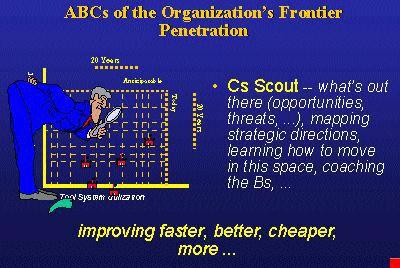 Fig.
17. 19E Fig.
17. 19ESo, we made a lot more progress in that than you probably thought about when this emerged about ten years ago. So, one way to think about is: "What's the C role? Is there a scout? You've got a frontier out there, in there a scout. Great. So, that frontier explodes like it is. God, there's a lot of territory, a lot of multi-dimension space out there, and a lot of things going on, and a lot of ideas floating around. How in the world to do a good job of C, then, is going to take more budget than we spend on even doing the B work. So, this comes a lot ..... 19F 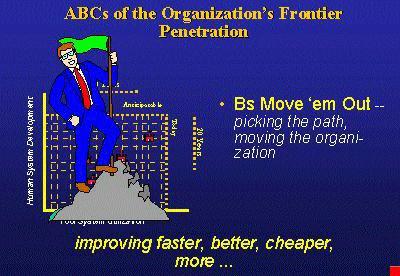 Fig.
18. 19G Fig.
18. 19GBut then the B--the B is sort of the wagon train boss. He's going to take us all out to that next place on that frontier. So, the two roles get kind of clearer when you look at that frontier sort of picture in its multi-dimensions. This is the kind of thing that we move ahead on and look at it. So, what would we do if we did that? Well, one thing to do is say, "Well, look how much C can cost!" 19H 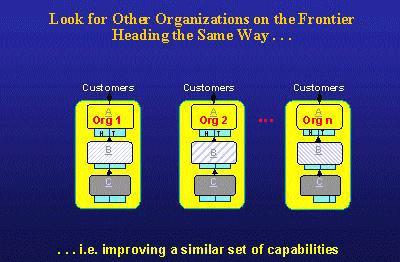 Fig.
19. 19I Fig.
19. 19IOh, let's look up and down this highway, or the street, or the state, or something, and find other organizations that are doing similar things, that have similar kinds of problems in the B. Why? 19J 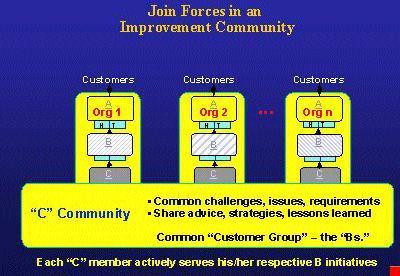 Fig.
20. 19K Fig.
20. 19KOh, because why don't we start collectively sharing some of the work, and energy, and resource, and cost that it takes to do a good job in C. Well, you don't have to look at that too much before you begin to realize the scale of the frontier opening up like that. Scouting that out and try to find out there's really something in it. Not enough the professional societies that are having more and more meetings, intensely trying to do it, or the consultants who are trying to do it. They don't have enough resources, enough input. It's a big, big job. So, doing it collectively has a big advantage. 19L You'll say, "Why don't I farm it out?" Consultants could do it. You'll say, "Well, I'll tell you why: because the way we should run this C community here--we call it improvement community, and that term is now another one in your vocabulary that we'll be using all the time. I'm going to make the next one of these things flat. Then I'll be as famous as for doing the mouse. Who would have thought? No, maybe you put a thumb break on the mouse--how about that? We could spend our time inventing here. 19M So, in this C community it's really interesting to think about the work that's there and this came out of our thinking, about a decade ago. Somehow I stumbled upon the whole quality movement. And, realized, "Oh! That's been a big kind of the way that they've done their quality movement," which they get together a lot and share. And, for a while we were having very intense meetings with people gathered every month, or so, and were planning how to do all this thing. And, one of them was saying, "Hey, we just won the Baldridge Award!" And now we've got these executives running around, who always used to be very worried about any things getting out to our competitors, and now they're doing this marvelous sort of statement saying, "Oh boy, compete like hell out the front door, and cooperate like hell out of the back door." 19N That quality movement was a really good example in
this; but its something to do that every consortium or, in a sense, every
one of a company's employees that goes out and works in a trade association,
or a professional society, is doing this--sharing a lot. And, there's
just no way you can get about it. And, there's another very, very important
thing that we get to if we say, "Oh, this C community's doing, okay, bootstrap."
Oh, why doesn't this C community start operating like a very advanced sort
of collectively intelligent outfit? 19O
From improvement community to MetaNIC. 20 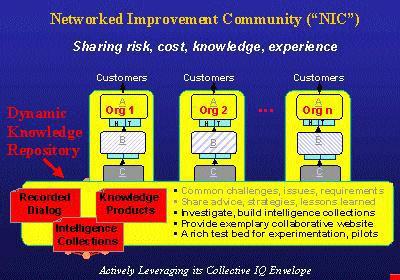 Fig.
21. 20A Fig.
21. 20AThis turns out to be a very good place to invest special resources and pile up operations that are actually working pilots of how you do collective knowledge work a lot better--which needs to be done out in the open so that you're sharing what the evolution of the standards and the vocabulary that has to go on. So, great. So, we just added a term: we call these network. Just for the sense of doing this a sort of networked way. And, so we could use the term NIC. 20B One interesting things is that in one of our meetings that we had some years ago, when the term was first coming out, people says, "Well, you've got this improvement community of yours--it's an IC, isn't it?" And, so they'd start pronouncing it, "ick" and say, "Hey, why don't you get with it and turn your IC into a NIC? So, positive term, NIC. So, this is part of the kind of the improvement infrastructure potential that we've been trying to highlight and study and think about. 20C But, it takes a lot of input for people to think about all of the pros and cons, and work out guidelines, and try to get a sort of a business case for doing this that would sell for hard-nosed people. And also go after examples, et cetera, to use. But also, that's one of the prime places in which you could do prototypical, dynamic knowledge repositories because you've got a lot of people co-operating in it. They could sort of share the costs and the sort of risks of doing that. And then, this comes about another thing of why, this kind of set-up, you couldn't duplicate with a consultancy is that this thing should be staffed by people contributed voluntarily for a certain period of time by the people out here in the customers of this. So, these people really are there living in this advanced prototype environment; really living with advanced ways to cooperate among themselves because they're given resources and the time and the encouragement to do it. And, when they go back, now they have the knowledge, the intrinsic kind of knowledge that's very hard to produce by just knowledge packages. And, they also have the experience in there. This grows to be a very attractive thing. And we say, "Oh. How come we thought of that?" I don't know, it just evolved. So, it turns out to be a very good one. So then, some years later we said it's a very important thing to learn how to do this, right? 20D And, just as it's very important for this neck to be helping these people learn how, they become better and better B's. Oh, why didn't we think of this earlier? 20E 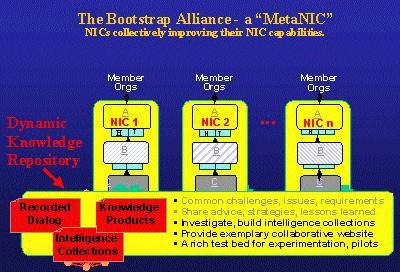 Fig.
22. 20F Fig.
22. 20FOh, why don't we go out and find interesting NIs and have them get together with an improvement community on how to improve NICs? Where the focus here is how you get to be a better and better NIC. And, you start looking into that, which we will do for the rest of the Colloquium, is dig into these kinds of examples of problems, and talk to people who have improvement communities. And, get them involved to say, "What's the problem and the challenge of improving, changing, this?" Just like, we'd like to get in a dialogue with organizations that would be progressive enough to say, "Hey, boy, there's some kinds of capabilities, especially this knowledge work and collective intelligence, et cetera, that we should probably keep up to bit. So why don't we find a good NIC to join and get active in that?" So, these things of how you develop a candidacy into sort of a value proposition to organizations to become members of an active NIC. How do you talk to active improvement communities about becoming NICs? How would you talk about a bunch of NICs into determining, how would you like to come into a MetaNIC that you end up calling the Bootstrap Alliance? Well, when does it stop? 20G There isn't any reason why, in different countries, you could have their MetaNICs talking to a super one. Or, the different states having a super one for the federal, et cetera. So that the potential for a multi-level infrastructure of this seems to be right there to study, and with the energy and sort of grasp of detail which--it's limited, believe it or not. But, I can't get in it. It's the kind of thing where we say, look, it isn't going to happen unless we get a bunch of people moving anyway. And, if they're going to be moving they need to have a sort of strategically organizing framework in order to do that. So, we'd like to offer this as setting the framework for organizations to do their evolving. And, this would go to say, hey, why not every state has its own kind of NIC inside it for all of the things it has to foster about the improvement of operations in the state. Well, then you'd have one for all the states. Well, make the states encourage the counties. Well then, they could tie together the counties. 20H So, we've actually been fortunate enough to resonate and connect with an organization called the National School Board Association that; it has fifty states and three regions, or whatever they call it. So, there are fifty-three members of it, each of them covers a region or a state. And, those have different other, down and like that. And, you say, "Boy, if we're going to improve K-12 education, you know, the school boards definitely have to be involved because they have to sort of be able to help monitor and control how things are happening." Then, somebody else points out, " Oh, we've got to get the parents in each community organized."" How do they get educated and trained? Oh, the teachers, also. Oh, the principals, also. Oh, the superintendents, also. So, those are all those candidates for--somehow they all have to migrate in their roles out there. And then, the whole possibility is the new way of working together might offer a very different structure by which those different schools are put together and organized and monitored, or regulated, of guided, or whatever like that. This is the case. So, anyway, there's just a lot to think about here in this sort of MetaNIC and NIC sort of thing. 20I 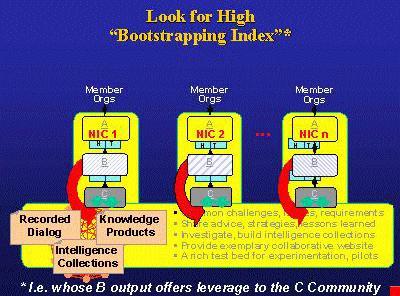 Fig.
23. 20J Fig.
23. 20JSo, one of the interesting things, then, comes about
as saying, "Oh, if we were going to go out and we had an alliance, a MetaNIC
put up like, we've got one that's a not-for-profit corporation that's already
set up waiting for some NICs to come and knock on the door. So, you say,
"Which ones would you like? Oh, let's go out and survey the different improvement
communities in the world." Well, which one of those, if we got them involved
as NICs, that the products of what they're learning how to do not only
would improve there, but also improve the MetaNIC? See the bootstrapping.
So, we made a beeline for the Association of Computing Machinery--it's
the largest computer society in the world--which has a bunch of special-interest
groups. So, we knock on the doors and say, "Oh." So, there's a computer-human
interaction, and a sig-web, that's hyper-media work, and there's a sig-group
for groupware and so on. And, we actually knocked on the doors and started
getting interest about them. But, it runs out of gas because the structure
that's there and how the financing is done just aren't really very shiftable.
For instance, a lot of them, the publications that they sell are part of
the revenue that the get, which makes a difference in how they could run.
20K
Academic publishing.21 In the world that's going to come, you're not going to have hard copy circulated like that. You're going to publish online. And, you're going to evolve from there. Oh, the academics point out, "Oh, but look! It's so important for us, in our own circle, in our own society, that we have our papers get reviewed by peers, especially the one's that go in the highest quality journal because the number of papers we get in those high quality journals is a very important part of how we get rated as doing our job as researchers in universities." I had one professor in molecular biology, or someplace like that got really angry with me, almost like the information-retrieval people did twenty-thirty years ago. Says, "You just don't understand the academic world. There's no way your going to break that. The peer-review system has been time-tested." 21A And, I'll say, "Well, let's talk about it awhile. I know that getting yourself reviewed of how much contribution you make is important. But, why does that have to be done before you publish?" 21B "Oh, because it puts it in the best journals." 21C "Well, look, why don't you just publish when you want to; right out there in the world? And, there'll be links. And, the professional societies would actually have links and stuff, so people can find you with no trouble at all and read you. And, then why don't you have a way in which the sort of commentary about you and the approval in that you get a dynamically rating system going along that just is continuous? And, so if your paper, nobody likes it at first, but nine months later they find out what it really meant and how it fit into something else here--oh, great. Well, in the way it is now you'd be, if you'd been published, it'd be in some great thing, or something, and you might not have gotten it published. And, what if it was sit there for longer? And, what if it was a really great thing, that was really hot and gave you all that credit, and they found out a huge flaw in it a year later?" 21D So the dynamic attributions of who's contributed to what is just a part of how this dynamic knowledge repository in its environment is going to have to work. And, you want it there anyway because if you're part of a big crew of people designing and producing aircraft its hard to put your own best ideas out there. You don't want some of them to get lost. 21E But, that's what it's going to take to have a team
design and team evaluation stuff do it right. So, the business about backtracking
on back links into doing attribution, or something, is a real challenge
--and extremely important in actually the sort of social aspect of getting
this knowledge stuff shared. People contribute as teams. And, they may
make it that a guy will get to be a full professor in five years after
he's an assistant professor because he puts out much more than paragraphs
at a time. We'll never get there the way it is now. So, it's better. So,
I'm going to ask Terry later about the real world of universities. How
likely is this to happen in the next five years, ten years, and twenty
years?
For one thing, you says, hey, the total knowledge
in the world is increasing in its rate of being produced, and if it gets
down to be every year, and every six months, and so on like that, that
everybody out there in a professional job has got to be learning all the
time. So, it isn't going to be any more that your college education, plus
what you pick up on the job with just osmosis, will be enough to keep you
in key. You're going to have to have it. So, who's going to be providing
something that has to be an organized, really advanced way to get not only
the new knowledge out there, but the ways in which you shift from the perception
of knowledge you did have into the way the new frameworks of knowledge
are going to be? That's the kind of role that universities have now. It's
got to be provided through a person's working life in not too many years
or decades from now. If the universities don't shift to be able to handle
that change in the external world, what are they going to do? This one
period here, if it's not compatible with the way it's going to continue,
nobody's going to want to go through that one. 21G
Learning about how knowledge is packaged. 22 The same thing will happen in K-12. That, more and more, it will just be a continuous evolution like there has been. You'll be reading out of books, you start doing that when you're, say, five or six. So, you're going to be learning about the way in which knowledge is packaged, optional viewing, moving around, verifying, et cetera, very early because the earlier you learn that, the more power that gives you for climbing the hill towards more knowledge. That means education can't be divided up like that. 22A So, there are lots of things about the future that, looking at this kind of scale we have, had to be dealt with. This high bootstrapping index is important about what kind of groups to sort of encourage the most. So, I'm going to be trying to get the ACM president to come in and giving a warning about this--and maybe some of the people in some of the special interest groups--as examples of talking about the problems, and difficulties, and challenges. And, this is what we'd like to do from different kinds of organizations. 22B I'm acquainted with the guy that's a state senator, I think he's a representative, but he's been very active for many years and very interested in education. So, what does it look like from there, the organizational things you need? Well, Jim Spores has built up a very interesting educational co-operative activity for some years with NSF funding. And, there are a lot of things they learned there, including back-link attributions, which was a good comment. So, we've got him tapped to come in later, too. 22C So, anyway, this is what we would really like to encourage
is for people to start bringing up and making us aware of more of the cases
of organizations or improvement communities, et cetera that are out there
that need--that are good candidates and from who you can learn--as well
as what's out there in the way of really novel tools and processes for
doing the kind of knowledge work we're talking about. As well as the processes
for every NIC and every MetaNIC is really a community of distributed participants.
22D
Future communities.23 And, there's going to be a lot to learn to how you
cultivate and develop that community. And, in a sense, they're going to
be managing more and more evolution on their own and change and resources
to invest. So, they have to have a governance process that gets to be better
than they are now. So, the whole business about distributed governance
is an important thing. And then, that needs to be phasing-in with the practices,
et cetera, about the way you govern many things in our political world.
All these things are going to be evolving simultaneously. And so, anybody
that starts out, "I'm going to go fix education," doesn't have the resources
or the orientation to be looking simultaneously at the rest of it. It's
sort of like, "I'm going to get this horseless carriage, but of course,
people ought to steer it like they ought to steer it, you know, with reins."
23A
National Bootstrap Alliances.24
So, then we start talking about the scalability of all of this, et cetera, and this sort of accidentally, but a fair amount to Jeff Rulifson's perseverance, and thoughtfulness, and many trips to Japan. Christine and I went with him. 24B And, what emerged in Japan is an organization that's actually called the Bootstrap Alliance Japan. And, its cousin is sitting right there. Dr. Ohashi is a university professor. And, he actually made a video to put in today, but we didn't know for sure we were going to get it in time to integrate it. So, we'll see it another time. You're here for the reception later this evening. And, are you going to come back every week? Well, Marcelo, who's in charge of that, says we might actually have time. So, I need to get through a few more things. We might be able to run it. So, don't go away and hide. All right, let's boost it a little bit here. Okay, so, the Bootstrap Alliance, let's say, the one we have now, there's the thought of saying, let's make that Bootstrap Alliance USA. 24C And then, we get a little bit of interest from Australia;
and then, we push some doorbells in Singapore; and, some people in Norway
with their oil money, and then it starts growing about the people that
say, "Oh, we can start getting something like that started in our country."
So, every country or, really, every nationality with its different cultures
and different environment, et cetera, needs to have its own way of evolving
at the same time as being interoperable with the rest of the world. So,
they need to be international in their sort of MetaNIC environment. But,
they also need the freedom to evolve the way they do. We might just really
learn that the Japanese focus on processing stuff--might find them suddenly
surging ahead of us. So, that's why we want to keep him on a short leash,
so we sort of know about that. 24D
High-performance teams.25
The thing that we really, really seriously thinking about in this bootstrapping pursuit is that the concurrent evolution of an open hyper-document system is a very critical sort of necessity. 25B So that's something where all the NICs and MetaNICs and all the national NICs of the world would really need to be serious about getting together with. So, all of the dynamic knowledge, development, et cetera, very early has to be that you get focused and get proactive end-user organizations and proactive sort of vendors, et cetera, involved in that, in a way. And, really proactively trying to explore: hey, how do we want these things to evolve? And, we don't want to get stuck in the same way that people got stuck with WYSIWYG where that's the only view you're going to get. You don't want to get stuck with people's perceptions about, hey, this is the way you've done knowledge all the time, and so this is the way. And you say, "Well, wait a minute." We're very, very flexible in the way we sense and perceive things and process them. We're very flexible. Anyone can learn how to ride a skateboard or something, or do a lot of other things. We can certainly learn different ways that we can harness ourselves to something like that. So, this leads to saying that some special part of the strategy has to be something that provides for that kind of open evolution." And, so, one of them is: really think seriously about putting together teams of people that are equipped, and trained, and employed that really are demanding high performance. 25C
And, you're not going to put any constraints on what they do. They do whatever they want to if they want to try it like that. But, in a competitive sense they need to have a performance assessment that also grows within these communities so you can rate them. This team is just terrific for this part of what's done it trying to do the integration. This one's terrific here, but you have to have both of them, both those capabilities. So, neither one does that bridging, so they'll probably have to find a different mix. So, getting that kind of open evolution, and open system, just sort of essentially demands that, well, you have to put it to work. You can't just have them sit there and demonstrate, "I can run up and down the field very quickly and rapidly." 25E
One important thing they can do is specialty support jobs in other organizations' dynamic repository. And, this has a separate kind of capability that the other people sort of see and witness their activity. Like our system we built in 1974 had shared screen, that anyplace in our upper network that somebody employing us ran into trouble and they call you up. And you say, "Okay." And you go through a little process. "Okay, now I'm seeing what's happening on your screen." That's good. "Oh. Okay. I see what you're doing now. Look, there are sets of things you can do. And, I can actually walk your way through it so pass the controls to me and do it." 25G So, we were doing that steadily from 1974. You get
published and talk about it, but it didn't fit paradigms. A lot of the
things you can do today can provide that sort of thing, but anyway. We
have to get faster evolution that's going in this thing. So, these are
the sorts of key deployments. We're going to come back to high-performance
teams and give them quite a bit of attention later. One aspect of doing
this, though, is your open hyper-document system can't do the kind of evolution
it does if you have only one interface. 25H
Benefits of openness.26
Then the architecture for the control of it has to be something that there's a verb-noun interface there that can do anything to anything that anybody wants to do. And, you can put whatever interface you want to that suits people's pursuits. So, hey, college kids that, "We want to try," and ones that know how to do skateboarding and everything else like that, can come in there. So, having these teams go, and then there's the question of how you deploy them, and that there are pictures for that, too. All this is going to be something about the future in there like that. 26B
Within the university this kind of thing of the integration of something you say, "Well, high-performance scholarship." So, why don't we, in a NIC, get stuff turned on about getting scholarship teams that can say, "Hey, we can put together a really effective textbook on this field and we can have it almost dynamically updated. It's never more than two weeks out of date," or something. So, that's the kind of thing we're going to need to do anyway. It'll be very important. And, then another aspect of this whole open-source movement is just terrific, and it's evolution. So, all right, that's the way the open hyperdocument system really should evolve. And there's another really interesting opportunity it. You say, "Okay, why doesn't that community live it?" So, when we built our systems, starting from about 1967, sort of about the time Jeff Rulifson came to work for us, we said, "Let's move our software on there." And, that really turned him on and off it went. So, from then on, for the next years, every line of source code is linkable. 26D
And, any comment field, you can have a link pointing to anything: requirements, users' guides, et cetera. Any of the field reports and problems can come in. Linking in between every passage, any object and any email could link to any other one, or could link to anything else out there. So, the way in which the field support could work--boy! 26F The software guy going to do this could write a little memo pointing to the messages came in and pointing to where the code was probably wrong. "And, I did a little exploring in there and it seems that our requirements over here were weak on that. And, we really ought to make a fix that these requirements would modify this requirement." So that-- just very effective in there like that. It's this kind of large scale sort of ... 26G It turns out that there are tactical people out there
in the world and there are strategic. And, in the military they made a
big difference about them. But it's the tactical guys that can take the
hills in the battles; that suffer to get all the notice out in the business
world. What we have to do is find people that can listen to strategy and
that we have to help co-develop a strategy, here that can fit the way the
world is. So, that's a big part of what we'll be talking about in the future.
26H
Plea.27 Instead of letting you go now, let's go and have Professor
Ohashi's live eight things. And, when that's done, you're free to move
around the country. And, I'll look forward very much to talking to you
at the reception. It's just terrific to have you, at least, sitting there
looking very attentive because I used to tell the students in university
that I know that's the way you get to be a professional student. That's
all you have to do is look very attentive, but not attentive enough to
get called on. I probably won't grab you and demand that you participate,
too much; but I'll urge it. And, I hope you get shamed maybe by the people
from the outside world that start coming in on email and sending messages
in. And, in that sense, our developing this, our own Bootstrap Alliance,
dynamic knowledge repository, is a key part of this whole exercise. If
we can't get that going then we'll have missed a very important part of
this. And, it's going to take more resources than we have now. We know
it. So, we'll either have to get money and hire people, or we have to get
volunteers that can be coherently involved with it enough to help do it
because we could get snowed very easily. Twenty people actively interacting
with us could probably bring us to a halt with the staff we have now. 27A
Bootstrapping in Japan.28 So, anyway, let's roll on Professor Ohash. 28A Why Japan as a nation could benefit from bootstrapping by Masakazu Ohashi, Dr.Eng., Graduate School of Policy Studies, Chuo University, Japan.28B Very brave. Very brave of you. 28C Ohashi in audience: Thank you. 28D One thing I'd like to announce: one of Professor's
Ohashi's--who also was an executive at Sun when all this got started, helped
make this happen--has donated one of his sons. So, Shinya, there standing
up behind Peter has been working with us since last fall and will be here
another few months, and just done a lot of good for us. Fits right in.
28E
Colloquium details.29 What I'd like to do is get Peter Yim--who's shy about this--to tell everybody a little bit more about what the infrastructure of tools and processes are that we're setting up initially--understaffed, underfunded--to handle this. Do you want to speak on that mic, or I'll loan you this one? 29A Peter Yim discusses requirements for Stanford University Certificate of Participation in the Colloquium.29B Thank you. That's going to be an important part, discuss that. Are there any sort of operational questions somebody might have? No fair asking me something substantive. What I'd like to do every time is sort of wave to somebody off. There's a fellow named Dave Evans, off in Australia. Hi, Dave. Jeff remembers him, and he said he's going to be watching. And he promised to try to develop a community going there. What would be nice is if you people would bring to attention people around the world that are watching seriously. I know there are people in Switzerland now already, in Norway, too, that would like to do. I'd like to feel like they're there watching. All right, in twenty minutes the reception starts. If they get there early, what happens? 29C Voice: It starts early. 29D Okay. So, everybody knows where the faculty club is? Okay, the class is adjourned. 29E
---
Above space serves to put hyperlinked
targets at the top of the window
|

